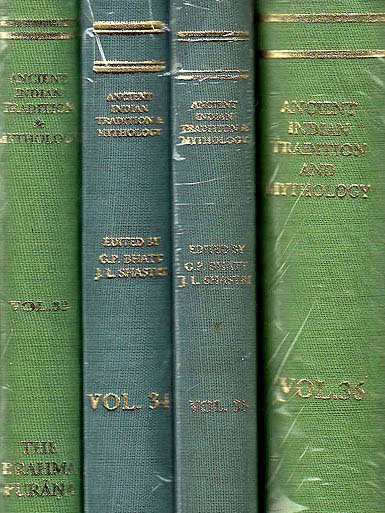The Brahma Purana
by G. P. Bhatt | 1955 | 243,464 words
This is the Brahma Purana in English (translation from Sanskrit), which is one of the eighteen Maha Puranas. The contents of this ancient Indian encyclopedic treatise include cosmology, genealogy (solar dynasty etc.), mythology, geology and Dharma (universal law of nature). The Brahma Purana is notable for its extenstive geological survey includin...
Chapter 44 - Description of the Holy Centre
The sages said:
1. O lord, we wish to hear the rest of the story of the king. After going to that excellent holy centre what did the lord of men do?
Brahmā said:
2. Listen, O leading sages, I shall mention briefly the vision of the holy centre that the king had and his activities thereafter.
3. After going to the holy centre well-known to the three worlds the king saw the beautiful (surrounding) regions and the rivers.
4. There is a sacred river there which takes its source from the foothills of the Vindhya Forest. It is a splendid river that dispels sins and it is known as Vindhyāpagā.
5. This river of great current is on par with Gaṅgā. It falls into the southern ocean. That excellent river of meritorious waters is known as Mahānadī.[1]
6. She is the beloved wife of the southern ocean. Her beauty is enhanced by hundreds of tributaries. There are villages and cities on either of its banks.
7. O leading sages, these villages are full of well grown plants. They are very charming and thronged by delighted and well nourished people. They are finely dressed and bedecked in ornaments.
8. The Brahmins, Kṣatriyas, Vaiśyas and Śūdras are found there engaged in their duties. They are splendid in their traits and very peaceful.
9-10 Their mouths are filled with betal leaves. They are bedecked in garlands and necklaces. The Vedic mantras fill the mouths of the brahmins. They have learnt the Vedic Mantras along with the six ancillary subjects. They have learnt the Vedic mantras by heart in their Padapāṭha and Krama Pāṭha. Some of them are engaged in Agnihotra and some in the holy rites of Aupāsana. They are experts in the scriptural topics. They perform sacrifices distributing wealth by way of Dakṣiṇās.
11-12. In the quadrangles, the royal highways, gardens, parks, assemblies, mansions and temples of the deities, the following are heard by the common people viz. the mythological traditions, Itihāsas and Purāṇas, the Vedic Mantras with their ancillaries and the characteristically good discourses on poetry and scripture.
13-19. The ladies who resided in that land were justifiably proud of their beauty and blooming youth. They were fully endowed with all characteristic marks. Their buttocks were ample. They were dark-complexioned but their faces resembled lotuses or the autumnal moon. They had plump and elevated breasts. Being prosperous they were beautiful to look at. They wore golden bangles and they were richly adorned by lustrous robes. They were as soft to the touch as the interior of the plantain tree. They had the lustre of the pollen dust of lotus flowers. They were lovely with the lower lips resembling the Bimba fruit and the eyes extending upto their ears. Their faces were beautiful and their tresses lovely. They were bent under the weight of necklaces. Their eyes resembled the petals of red or blue lotus. Other slender-bodied ladies had their teeth sparkling like the streaks of lightning. Their forelocks were curly. They shone with their hairs partitioned on upper side. Their necks were made beautiful due to the various ornaments. They were bedecked in garlands and necklaces. With their earrings studded with jewels and the beautiful Karṇapūras (ear-ornaments) they were seen resembling the celestial women. They had splendid traits.
20-22. These excellent ladies dallied with highly blessed bride-grooms singing divine songs. They sported about with various musical instruments such as lutes, flutes, Mṛdaṅga, drums and other types of drums like the Paṇavas, Gomukhas and Dundubhis. The conches too produced sweet sounds. Sporting about with sweet musical instruments these elegant ladies delighted one another. Expertly playing in these musical instruments and singing sweetly, these excellent ladies were gay and jolly, mad and passionate, by day and night.
23. The whole of that holy centre was frequented by mendicants, recluses, Siddhas, householders, religious students, those who had mastered Mantras, those who had realised self by practising austerities and those who had become Siddhas by means of performing sacrifices.
24-25. The king, thus saw the rarest of holy centres. He thought—Here itself I shall propitiate the eternal lord Viṣṇu, the great lord, the preceptor of the universe, the sole redeemer, the supreme saviour, the infinite lord of chiefs of all, the unvanquished lord.
26-30. This is now known to me as the mental Tīrtha Puruṣottama. It is the place where the huge holy fig tree stands like the Kalpa tree[2]. The idol having the lustre of sapphire has been hidden by the lord himself. There is no other splendid idol of Viṣṇu seen anywhere. I shall endeavour to make Viṣṇu the lord of the universe of truthful exploit visible to the eye. I shall duly observe excellent holy rites by performing sacrifices, charitable gifts, austerities, meditations, worships and observances of fasts. With the mind not resting on any other topic, with the mind dwelling on him and not thinking of anyone else, I shall begin the preliminary activities for the construction of Viṣṇu’s abode.
Footnotes and references:
[1]:
Mahānadī—a river celebrated in the Purāṇas and flowing through the region of Utkāla (Orissa).
[2]:
Kalpa-vṛkṣa—a tree in paradise. It gives any object which a person desires to get.
